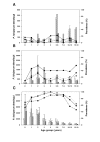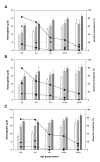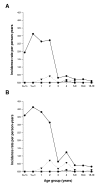Malaria morbidity and immunity among residents of villages with different Plasmodium falciparum transmission intensity in North-Eastern Tanzania
- PMID: 15282030
- PMCID: PMC514496
- DOI: 10.1186/1475-2875-3-26
Malaria morbidity and immunity among residents of villages with different Plasmodium falciparum transmission intensity in North-Eastern Tanzania
Abstract
Background: The relationship between the burden of uncomplicated malaria and transmission intensity is unclear and a better understanding of this relationship is important for the implementation of intervention programmes.
Methods: A 6-month longitudinal study monitoring risk factors for anaemia and febrile malaria episodes was conducted among individuals aged below 20 years, residing in three villages of different altitude in areas of high, moderate and low malaria transmission intensity in North-Eastern Tanzania.
Results: The burden of anaemia and malarial fever fell mainly on the youngest children and was highest in the village with high transmission intensity. Although a considerable percentage of individuals in all villages carried intestinal worms, logistic regression models indicated that Plasmodium falciparum was the only significant parasitic determinant of anaemia. Interestingly, children who carried low-density parasitaemia at the start of the study had a lower risk of contracting a febrile malaria episode but a higher risk of anaemia during the study period, than children who were slide negative at this point in time.
Conclusion: Young children living in the high transmission village carried a very high anaemia burden, which could be attributed to malaria. The overall incidence of febrile malaria was also highest in the high transmission village particularly among those under five years of age. These data suggest that in rolling back malaria, available resources in prevention programmes should primarily be focussed on young children, particularly those residing in areas of high malaria transmission.
Figures



References
-
- Christophers SR. The mechanism of immunity against malaria in communities living under hyper-endemic conditions. Indian J Med Res. 1924;12:273–294.
-
- Bruce-Chwatt LJ. A longitudinal survey of natural malaria infection in a group of West African adults. W Afr Med J. 1963;12:141–173. - PubMed
-
- MacDonald G. The epidemiology and control of malaria. London: Oxford University Press; 1957.
Publication types
MeSH terms
Substances
LinkOut - more resources
Full Text Sources

